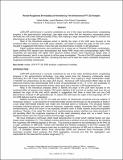Resist roughness Bi-modality as revealed by two-dimensional FFT 2D analysis
Author(s)
Cann, Susan G.; Fedynyshyn, Theodore H.; Baranov, Leonid; Gotkis, Yehiel
DownloadGotkis-2009-Resist roughness Bi-modality as revealed by two-dimensional FFT 2D analysis.pdf (831.5Kb)
PUBLISHER_POLICY
Publisher Policy
Article is made available in accordance with the publisher's policy and may be subject to US copyright law. Please refer to the publisher's site for terms of use.
Terms of use
Metadata
Show full item recordAbstract
LER/LWR performance is currently considered as one of the major stumbling blocks complicating progress in the semiconductor technology. Line edge scans show that low frequency components clearly dominate the LER Power Spectral Density (PSD), thus implying a large characteristic length (>100-500 nm) phenomenon as the major LER source. Most of the theoretical analyses aimed to identify the origin of the LER were focused on the combined effect of exposure and CAR action statistics, and failed to explain the origin of this limit, which resulted in suggestions that there is more than just one phenomenon involved in LER generation. Depth profiling experiments were performed for a broad set of Polymer-PAG-Base combinations. Depth profiling PSD spectra have demonstrated that higher RMS values and correspondingly higher PSD amplitudes are associated with tighter PSD spectrum shifted towards lower frequencies (larger sizes of roughness features), which is very typical for all the cases investigated. The set of the PSD spectra obtained exhibit a pronounced bi-modal structure, indicating that there are at least two clearly noticeable independent roughness-controlling mechanisms.
Date issued
2009-04Department
Lincoln LaboratoryJournal
Proceedings of SPIE
Publisher
The International Society for Optical Engineering
Citation
Gotkis, Yehiel et al. “Resist roughness bi-modality as revealed by two-dimensional FFT 2D analysis.” Advances in Resist Materials and Processing Technology XXVI. Ed. Clifford L. Henderson. San Jose, CA, USA: SPIE, 2009. 727345-10. © 2009 SPIE--The International Society for Optical Engineering
Version: Final published version
ISSN
0277-786X